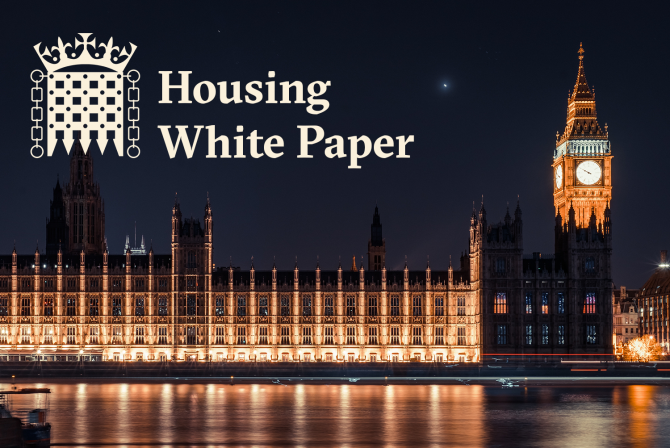29 key points in the Housing White Paper
By lucmin on 8th February 2017

The government has set out 29 key points in its Housing White Paper.
Communities Secretery Sajid Javid confirmed many of the policies already announced or leaked in recent days and weeks.
He said that in addition to the ban on letting agents’ fees levied on tenants in England, he would “go further” to introduce longer tenancies and to bring in more institutional investment in rental housing, claiming: “We’ll improve safeguards [for tenants] in the private rented sector.” Build To Rent – the institutional investment creating purpose-built homes to let – will have three year tenancies as standard.
He also said he would maintain the Starter Homes initiative introduced by the Cameron government and would “tackle the scourge of unfair leasehold terms, too often forced on to hard-pressed homebuyers” by new build developers.
He also pledged that he would seek to cut planning red tape, oblige land-owning private developers to undertake a ‘use it or lose it’ policy with the risk of losing planning consent, and once again pledged to free public land for house building.
There would be no threat to the Green Belt, he promised.
All 29 policies outlined in the White Paper are here:
- Making sure every part of the country has an up-to-date, sufficiently ambitious plan so that local communities decide where development should go;
- Simplifying plan-making and making it more transparent, so it’s easier for communities to produce plans and easier for developers to follow them;
- Ensuring that plans start from an honest assessment of the need for new homes, and that local authorities work with their neighbours, so that difficult decisions are not ducked;
- Clarifying what land is available for new housing, through greater transparency over who owns land and the options held on it;
- Making more land available for homes in the right places, by maximising the contribution from brown eld and surplus public land, regenerating estates, releasing more small and medium-sized sites, allowing rural communities to grow and making it easier to build new settlements;
- Maintaining existing strong protections for the Green Belt, and clarifying that Green Belt boundaries should be amended only in exceptional circumstances when local authorities can demonstrate that they have fully examined all other reasonable options for meeting their identi ed housing requirements;
- Giving communities a stronger voice in the design of new housing to drive up the quality and character of new development, building on the success of neighbourhood planning; and
- Making better use of land for housing by encouraging higher densities, where appropriate, such as in urban locations where there is high housing demand; and by reviewing space standards;
- Providing greater certainty for authorities that have planned for new homes and reducing the scope for local and neighbourhood plans to be undermined by changing the way that land supply for housing is assessed;
- Boosting local authority capacity and capability to deliver, improving the speed and quality with which planning cases are handled, while deterring unnecessary appeals;
- Ensuring infrastructure is provided in the right place at the right time by coordinating Government investment and through the targeting of the £2.3bn Housing Infrastructure Fund;
- Securing timely connections to utilities so that this does not hold up getting homes built;
- Supporting developers to build out more quickly by tackling unnecessary delays caused by planning conditions, facilitating the strategic licensing of protected species and exploring a new approach to how developers contribute to infrastructure;
14.Taking steps to address skills shortages by growing the construction workforce;
- Holding developers to account for the delivery of new homes through better and more transparent data and sharper tools to drive up delivery; and
- Holding local authorities to account through a new housing delivery test.
- Backing small and medium-sized builders to grow, including through the Home Building Fund;
- Supporting custom-build homes with greater access to land and nance, giving more people more choice over the design of their home;
- Bringing in new contractors through our Accelerated Construction programme that can build homes more quickly than traditional builders;
- Encouraging more institutional investors into housing, including for building more homes for private rent, and encouraging family- friendly tenancies;
- Supporting housing associations and local authorities to build more homes; and
- Boosting productivity and innovation by encouraging modern methods of construction in house building;
- Continuing to support people to buy their own home – through Help to Buy and Starter Homes;
- Helping households who are priced out of the market to afford a decent home that is right for them through our investment in the Affordable Homes Programme;
- Making renting fairer for tenants;
- Taking action to promote transparency and fairness for the growing number of leaseholders;
- Improving neighbourhoods by continuing to crack down on empty homes, and supporting areas most affected by second homes;
- Encouraging the development of housing that meets the needs of our future population and helping the most vulnerable who need support with their housing, developing a sustainable and workable approach to funding supported housing in the future; and
- Doing more to prevent homelessness by supporting households at risk before they reach crisis point as well as reducing rough sleeping
